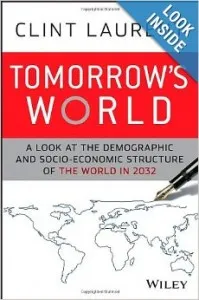[Book Review] Tomorrow's World: A look at the demographic and socio-economic structure of the world in 2032

Tomorrow's World maps out the world's near future through the lens of demography. It provides a global perspective of how the nature of demographics, household incomes, and expenditure patterns might be expected to change over the next 20 years.
Clint Laurent is the founder and managing director of Global Demographics, formerly called Asian Demographics. Based in Hong Kong, he founded and sold two research firms: Asia Market Intelligence (now Synovate) and Asian Studies. He has a PhD in marketing and statistics from Bath University in the UK.
While the fastest-moving technology world with its ups and downs gets lots of headlines for quarterly and annual forecasts, demographic trends are slower and more stable, Laurent explains.
The book provides key demographic data for 74 countries, comprising 79% of the world's population and 92% of global GDP (though data from sub-Saharan Africa was unavailable and is therefore a disappointing omission in the book).
The mapped countries are divided into nine regions: North America, Western Europe, Eastern Europe, North Africa/The Middle East, South America, Affluent Asia-Pacific (Japan, Australia, Taiwan, South Korea, Singapore), Developing Asia (Bangladesh, Cambodia, Indonesia, Malaysia, Pakistan, Philippines, Sri Lanka, Thailand and Vietnam), China and India. These two countries, India and China, are categories of their own due to their huge size.
The data is interesting in its own right, but Laurent digs deeper to show broader trends and how they impact health and wealth; death and taxes; buying and selling; education and progress; and how and where we choose to live.
North America, Western Europe, and Affluent Asia—with 18% of the world's population in 2012—account for 69% of total consumer spending and 71% of the world’s earned incomes. They are also expected to account for 41% of the growth in consumer spending over the next two decades.
While Japan is on average getting older, so is the changing nature of its employment practices (eg. rehiring of elder women) such that the number of dependents per employed person remains one of the lowest in the world. It will have enough workers to support the aged population (and grow the economy) for the next 20 years.
While India has a poor standard of education relative to the world, 49% of its labour force in 2032 will enter the labour force sometime after 2012. India has a potential demographic dividend in terms of a large number of persons reaching working age.
However, the economy will only benefit if they can find employment—at the rate of six million extra jobs a year for the next two decades. Therefore, getting education right now will pay dividends. Otherwise, India's economic and political future is at risk as a result of having a large, poorly skilled working-age population struggling to find employment – a ‘demographic time bomb.’
Female employment in India is only 39% of working age females (between 15 and 64 years of age), while in China it is 79% (higher than North America: 63 per cent). India thus needs to do much more to bring about changes in cultural attitudes so as to increase female participation in the workforce. Output of a country thus depends not just on size and productivity of its workforce but also the participation rate, particularly of females.
India has 252 million households and a household size of 4.7 persons; China has 433 million households and an average household size of 3.1 persons. 53 per cent of households in China are childless; only one in 10 households in India is childless (such differences impact consumption patterns and preferences).
China's workforce will decline in absolute numbers by 18% over the next 20 years (by 6% in the next decade). Future economic growth will depend on big increases in productivity per worker.
China’s population will peak in 2018 and decline thereafter; India will have a larger population than China by 2024. China is estimated to have added 13 million babies in 2012, which will decline to eight million babies added in 2032. In contrast, India will add 25 million babies every year for the next 20 years. The average household size will not change significantly in that period. The average household in India has more people than China, but also fewer wage earners.
Only 32 per cent of India’s workforce has more than primary education, as compared to 70 per cent for China. To delay education investment will be an opportunity lost for India, Laurent observes. Malaysia is now reaping the benefits of its earlier broad-based education drive, and Thailand and Indonesia are now getting the education strategy right.
China has one of the lowest household dependency ratios in the world (number of dependents per employed person per household). “This has been a significant factor behind the increased consumer spending that has been taking place in the last few years,” says Laurent. The number of affluent households in China (income greater than $100,000) will shoot up from less than a million in 2012 to 17.7 million in 2032.
The nature of the household is changing, and the household is the key decision unit for many purchases. Average household sizes have been declining in every region for the last decade. “The empty nester household is a growth segment,” Laurent explains.
These trends could have important implications for businesses planning their long-term strategy: it is common to develop products and services for the youth boom, but in the long term the ageing population will be the bigger market segment.
Already, 41% of all households in the world have no person less than 19 years of age in them. In the more affluent and older countries, it is 62% of households. By 2032, this will reach 47% and 68% respectively, meaning household consumption requirements will change dramatically.
In terms of age, there are 534 million people around the world who are older than 64 now, but there will be 970 million by 2032 (with a third of these in China) – an 81 per cent increase. This has serious implications for the healthcare system and insurance.
The book has received praise for raising thought-provoking questions and interpretations, but has also come under criticism for not clearly explaining how the source data was treated or for ignoring the influence of disruptive political and technological factors.
For example, who would have predicted the end of the Cold War or the rise of the Internet economy, and how these developments would change business? The author admits, though, that there are factors such as migration which can change the data projections; he briefly mentions technologies like 3D printing and robotics which can impact work and home life.
Other factors which should not be overlooked are tax levels (high in Europe but they cover health and education costs), the way loans and home mortgages are classified in different countries (savings or expenditure) and metrics such as overall consumer base and profit per customer.
In sum, this book is a good read which blends statistics with thought-provoking questions, as well as lots of insights and inspiration for entrepreneurs, policymakers and educators.


![[Book Review] Tomorrow's World: A look at the demographic and socio-economic structure of the world in 2032](https://images.yourstory.com/cs/wordpress/2013/12/tomo.jpg?mode=crop&crop=faces&ar=16%3A9&format=auto&w=1920&q=75)




